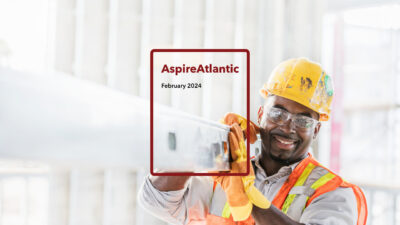I believe Nova Scotia—and Canada for that matter—is at a crossroads. Decisions we make now could impact the wellbeing of Canadians for generations to come. I am not specifically talking about tariffs or a brewing trade war. I am talking about government, civil society, the private sector, and advocacy groups, and how they all need to work better together for the good of the province and country.
Premier Tim Houston released a letter to his Progressive Conservative Members of the Legislative Assembly recently about the need for his government to invest in developing the province’s vast natural resources as a means toward greater economic self-sufficiency. The ensuing debate couldn’t have come at a more critical time. While I will root my thoughts in the Nova Scotia context and through the lens of Premier Houston’s letter, this perspective could be applied to most everywhere else I have worked and visited in Canada.
With the threat of punishing US tariffs and a trade war, Canadians from coast to coast to coast can be forgiven if we are yearning for a return to dull predictability. With this wild ride just beginning, we must not be so intent upon lashing ourselves to the mast that we fail to plot our course for calmer economic waters and a brighter future.
A trade war will be felt in every community and household in Canada. Couple this with troubling productivity stats for Nova Scotia and a downturn in immigration that have both generated new tax revenue and challenged public service delivery, and the headwinds we face become clear. And, yet, with every crisis comes opportunity to reflect honestly and act differently.
During the pandemic crisis, Nova Scotians embraced a culture of resilience and innovation as we launched some of the most progressive and effective public health measures in the country. This helped generate economic growth, by encouraging immigration and repatriation at higher levels than the rest of the country and prepared us to open society back up more quickly.
Today, our province faces a slowing economy and a looming threat of the same magnitude that we faced in 2020. We can rely on our federal government to provide us with the financial supports it has before, but we all know the bills will eventually come due.
I’d like to propose an alternate approach.
What if we came together as a province—the private sector, communities, and government—to become a national leader in building a 21st century economy? What might this look like?
This may feel a bit daunting, even unrealistic. But I think we have the ingredients necessary to build a thriving, community-based economic engine that could be the envy of others.
It will require new, balanced approaches to: innovation, regulation, and participation.
Innovation
New approaches to problem-solving need to come in a variety of forms and not the “innovation theatre” of Post-It note covered walls leading to the rapid launch of poorly conceived ideas that aren’t ready. I have seen the desire to innovate within both the private and public sectors, without understanding the risk acceptance this truly takes.
We have lacked understanding and investment in innovation which has partly led to poor productivity. “Nova Scotia ranked near the bottom of provinces across a wide array of productivity measures and productivity improvement was outpaced by competitors. This has meant slow growth in real GDP and declining real GDP per capita,” found the Halifax Partnership’s 2024 Halifax Index.
We need to make a generational investment in smart innovation, looking at what will drive the 21st century economy in alignment with our province’s strengths and resources. The Premier has smartly identified opportunities in his letter, including green energy produced from offshore and onshore wind and lithium used to produce batteries. There is global demand for these commodities, and we need to create an environment that encourages private sector investment in these large-scale infrastructure projects.
I believe our strong post-secondary sector positions us well to become a leader in digital technologies and artificial intelligence. We have only scratched the surface of these areas across the globe, and Nova Scotia can become a leader in using innovation in technology and AI to solve societal issues. For instance, at Davis Pier we looked at the use of technology and automation to increase innovation in affordable housing. We have also worked with the global digital technology leader Kainos to build tools that use AI to support people receiving social services. These are important investments in innovation that will both create new economic opportunities and solve societal issues.
As I have long said, you can have a good business by being in the business of doing good.
The scary thing about real innovation is the need to invest in the unknown. It takes courage and an acceptance that not everything invested in will work out. We can’t yet fully understand the green hydrogen market, emerging battery technologies, or how the ethical use of AI will shape our future. But to wait for certainty is to miss opportunity.
It’s time for all of us to take a courageous leap of faith towards becoming a much more innovative, and productive, province.
Regulation
I have spent a career working with regulators from around the world. They are passionate professionals focused on ensuring the protection of people and planet. The best regulators are those who are determined to “get to yes” on projects. I’m not suggesting that government needs to rush approvals without due consideration for safety and security. In a world of uncertainty, though, we will need to accept more risk in the name of progress.
Some risk can be mitigated by taking an innovation mindset to regulation and public service. This means better, more genuine involvement of people that bring various perspectives. It means thinking about “safe to fail” ways to test hypotheses and prototype ideas. It means understanding that a regulator’s role is more about helping to safely achieve an economic outcome for the good of society than assessing a situation against a static set of rules.
Premier Houston referenced how long it has taken in the past to get projects approved. Over many years, I watched this culture develop through political decisions, public sector norms, and the pressure of competing agendas. Private sector investment and approaches to project approvals will never make everyone happy. What we will need is smart, risk-based, outcome-focused regulation to swiftly assess high priority projects – to advance them or reject them and move on.
Participation
At its best, democracy is an act of public participation. Unfortunately, the opportunities for people to participate are few-and-far between. I believe this is the product of unintentionally poor participatory design and a growing public mistrust in government. These days, people cast a ballot once every four years and then either check out or complain until the next election rolls around.
If we are to make a transformational shift as a province and country, we need more people engaged in more of our key decisions.
Disengagement has created a disproportional influence by fewer individuals, or the 2% speaking for the 98% as our Premier calls them. Whether you call them “lobbyists”, “big business”, “special interest groups”, or “industry associations”, I have seen it first-hand. I’m not suggesting that these groups don’t have a role to play in the process. But they do not (and cannot) speak for everyone.
Throughout my career, I have conducted more public consultation and community engagement sessions than I can count. And do you know what is regularly missing from the sessions?
That’s right: the public and community.
The people that show up are rarely a representative sample of Nova Scotians, and even more rarely represent traditionally marginalized communities. Layer on that many people have already formed their opinions and are not interested in listening to other perspectives. People from within community rarely participate in the conversation, nor are they sufficiently aware of the various pros and cons to have an informed opinion. Public sentiment is then shaped mainly by the effectiveness of the communications approaches of advocates.
For this critical economic shift to happen, Nova Scotians need to understand risks and rewards. We all need to be diligent in both informing and listening. Let’s connect dots for people from economic investment to job growth, from government revenues to personal economic wellbeing, from better outcomes for their children to improved community health. Most importantly, we need to listen to their hopes and their concerns in a productive dialogue that actually influences and shapes decisions.
This isn’t about cutting out those organizations that represent specific industries, movements, or interests from the discussion—but it is about realizing they don’t speak for everyone. What we need is community-informed decisions. If we are talking about making a fundamental shift for the province, I believe it will take a movement to create this momentum.
Where to from here?
As I said in my first sentence, I think we’re at a crossroads. One direction is some version of the status quo, the easier, more known and comfortable route. Behavioural science shows us that people are wired to prefer the status quo, so we are already fighting an uphill battle. And there is comfort in continuing on our existing path. But after a tumultuous couple of weeks of hearing about tariffs, trade wars, and annexations, I think it’s fair to say that the future is uncertain and perhaps the “path of least resistance” isn’t leading us to where we want to go.
The other path, the one that may have seemed risky to us in the past, is the one I think we should take: a measured, balanced approach to considering the art of the possible for us as a province and country. This path will not be short. We will not see immediate benefits in a year or two, but the sooner we start on this journey towards productivity and self-sufficiency, the sooner we will reap the benefits.
We have an opportunity to be a province that embraces the best of what we have been alongside the possibilities of what we can be. If we build a broader economy, we can create opportunities from Sydney to Yarmouth and meet the demand for high quality public services – health care, public education, housing, and provide more help for those who need it most. Done well, economic prosperity enables social wellbeing.
If this were easy, we would already be well-insulated from the new president’s whims. Now is not the time to wait and see if the threats are real; it’s the time to act with urgency to set a new course for this province.
Getting there demands:
- Smart, risk-based, outcome-focused regulation.
- Community-informed decisions.
- Investing in our natural strengths to create economic self-sufficiency and prosperity for more Nova Scotians.
- Being in the business of doing good.
None of this is radical. But it will require us to change how things get done and, perhaps more importantly, accept that not every step will be perfect. Regardless of political ideology or stripe, I hope we can agree that we need a more courageous path forward.
I may not have all the answers, but I know the right ones are balanced, thoughtful, and closest to community.



